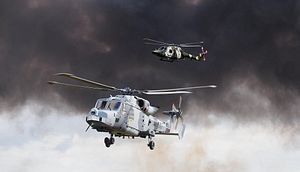The Republic of Korea Navy (ROKN) has commissioned its last batch of four AgustaWestland AW Wildcat 159 shipborne anti-submarine warfare (ASW) helicopters and deployed the aircraft with a “frontline fleet for combat operations,” Yonhap news agency reported on July 5.
“The remaining four [helicopters] were deployed at a front-line fleet and put into maritime operations today,” the ROKN said in a statement. The Navy did not reveal the exact location of the deployment but it is likely that the new helicopters are stationed aboard surface warships — likely Incheon-class guided-missile frigates — operating along South Korea’s western sea border with North Korea.
The helicopters were handed over by Leonardo’s Helicopter Division to the ROKN in November 2016. “Initially, the AW Wildcat 159s were slated for delivery by the third quarter of 2015,” I reported in 2016. “However, the introduction has been delayed by a corruption scandal inside South Korea’s military on the one hand, and delays during so-called site acceptance tests (SATs) on the other hand.”
The helicopter is specifically designed to operate from smaller surface warships, as I explained elsewhere (See: “South Korea Receives 4 New ‘Submarine Killer’ Helicopters”):
The helicopter, “designed to operate from the smallest helicopter-capable ship,” according to the the Leonardo-Finmeccanica company website, is powered by two LHTEC CTS800-4N engines and has a maximum range of 265 nautical miles (490 kilometers). It primarily functions as a ASW aircraft, but can also be deployed in other missions.
“The platform is equipped with the latest communications, navigation systems, advanced sensors and a wide range of weapons, providing mission commanders with Intelligence Surveillance and Reconnaissance (ISR), Maritime Interdiction Operations (MIO), Anti Surface Warfare (ASuW), Anti Submarine Warfare (ASW) and Search and Rescue (SAR) capabilities,” according to the company website.
The helicopters will be equipped with a Selex Seaspray 7000E active electronically scanned array radar and a Thales Compact FLASH Sonics low-frequency, long-range dipping sonar system, next to other ASW sensors, including sonobuoys.
The multi-mission maritime helicopter will likely be armed with Spike NLOS missiles, K745 Cheong Sangeo (Blue Shark) light-weight torpedoes and depth charges. The aircraft can stay in the air for 2-3 hours depending on the load.
The ROKN currently operates eight AW-159s but plans to induct another 12 helicopters by 2022 under the Maritime Operational Helicopter program. South Korea’s Defense Acquisition Program Administration (DAPA) has budgeted around $770 million for the acquisition of 12 additional helicopters. An agreement is expected to be concluded by 2018.
Leonardo-Finmeccanica is expecting a follow-up order. Other models under consideration are Sikorsky’s MH-60R and NHIndustries’ NH-90 multirole military helicopter. However, “it is highly likely that South Korean authorities will stick with the AW-159 given that it outperformed the U.S.-made MH-60R Seahawk helicopter during a competitive bidding process in 2012 and has been performing to the satisfaction of the ROK Navy in tests so far,” I explained elsewhere.































